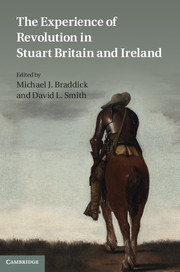Book contents
- Frontmatter
- Contents
- Notes on contributors
- Preface
- List of abbreviations
- JSM
- Introduction: John Morrill and the experience of revolution
- 1 The Scottish–English–Romish Book: the character of the Scottish Prayer Book of 1637
- 2 Popery in perfection? The experience of Catholicism: Henrietta Maria between private practice and public discourse
- 3 Sir Benjamin Rudyerd and England's ‘wars of religion’
- 4 Rhetoric and reality: images of Parliament as Great Council
- 5 Cathedrals and the British Revolution
- 6 History, liberty, reformation and the cause: Parliamentarian military and ideological escalation in 1643
- 7 Sacrilege and compromise: court divines and the king's conscience, 1642–1649
- 8 Law, liberty, and the English Civil War: John Lilburne's prison experience, the Levellers and freedom
- 9 On shaky ground: Quakers, Puritans, possession and high spirits
- 10 James Harrington's prescription for healing and settling
- 11 ‘The Great Trappaner of England’: Thomas Violet, Jews and crypto-Jews during the English Revolution and at the Restoration
- 12 The Cromwellian legacy of William Penn
- 13 Irish bishops, their biographers and the experience of revolution, 1656–1686
- 14 Religion and civil society: the place of the English Revolution in the development of political thought
- Bibliography of the major writings of John Morrill, 1967–2009
- Index
11 - ‘The Great Trappaner of England’: Thomas Violet, Jews and crypto-Jews during the English Revolution and at the Restoration
Published online by Cambridge University Press: 05 August 2011
- Frontmatter
- Contents
- Notes on contributors
- Preface
- List of abbreviations
- JSM
- Introduction: John Morrill and the experience of revolution
- 1 The Scottish–English–Romish Book: the character of the Scottish Prayer Book of 1637
- 2 Popery in perfection? The experience of Catholicism: Henrietta Maria between private practice and public discourse
- 3 Sir Benjamin Rudyerd and England's ‘wars of religion’
- 4 Rhetoric and reality: images of Parliament as Great Council
- 5 Cathedrals and the British Revolution
- 6 History, liberty, reformation and the cause: Parliamentarian military and ideological escalation in 1643
- 7 Sacrilege and compromise: court divines and the king's conscience, 1642–1649
- 8 Law, liberty, and the English Civil War: John Lilburne's prison experience, the Levellers and freedom
- 9 On shaky ground: Quakers, Puritans, possession and high spirits
- 10 James Harrington's prescription for healing and settling
- 11 ‘The Great Trappaner of England’: Thomas Violet, Jews and crypto-Jews during the English Revolution and at the Restoration
- 12 The Cromwellian legacy of William Penn
- 13 Irish bishops, their biographers and the experience of revolution, 1656–1686
- 14 Religion and civil society: the place of the English Revolution in the development of political thought
- Bibliography of the major writings of John Morrill, 1967–2009
- Index
Summary
trepanner (archaic): one who ensnares; an entrapper, decoy, swindler
Oxford English DictionaryOn 24 February 1660 one Tobias Knowles – most likely Tobias Knowles (d.1669), pewterer of St Peter Cornhill, London, and afterwards a common councilman – gave evidence at the London sessions of the peace held in the Old Bailey. Knowles was charged with forging foreign coinage, a less serious offence than counterfeiting coin of the realm, which was a treasonous capital crime. He was to be declared innocent by a jury, but what is interesting for our purposes is that his testimony reveals details of a plot. Although Knowles's evidence cannot be regarded as entirely trustworthy because he sought to avoid implicating himself, a narrative can still be pieced together. In early spring 1659, accompanied by Thomas Violet (1609?–1662), a scheming goldsmith and possibly also his neighbour, Knowles claimed to have gone to ‘Dukes-Place’ in London's East End. There the pair apparently entered the ‘Synagogue of the Jewes’ where they spoke with ‘Mr. Moses their High-Priest’ and some other unidentified Jews with whom Violet was apparently ‘very conversant’. These details can be substantiated. On 19 December 1656 a hitherto secret Jew of foreign origin called Antonio Carvajal (c.1596–d. 1659) had, following his endenization, signed a 21-year lease for a brick tenement on Creechurch Lane in the parish of St Katherine Creechurch. By March 1657 this structure was being converted into a synagogue.
- Type
- Chapter
- Information
- The Experience of Revolution in Stuart Britain and Ireland , pp. 210 - 230Publisher: Cambridge University PressPrint publication year: 2011
- 1
- Cited by



